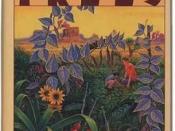Since the times of our primate ancestors, we humans have lived in groups affiliated by consanguineous, romantic, or simply mutually-advantageous relationships. However, the exact definition of these human social groups we call ÃÂfamilyÃÂ varies wildly depending on social norms and moral and religious values. In the United States, and in other nations, many still steadfastly assert that in order for a family to be legitimate, and functional, it must follow the ÃÂtraditionalÃÂ standards. This, of course, means there should be a breadwinning father and a subservient wife and children. Needless to say, in most of the world, especially the West, this idealization of what a family should be is less and less common, with blended families, homosexual couples, and other ÃÂuntraditionalÃÂ families becoming more common and socially acceptable. Barbara Kingsolver believes very strongly in the legitimacy of these ÃÂuntraditionalÃÂ families and her novel The Bean Trees explores this topic thoroughly.
Personally, I define ÃÂfamilyÃÂ as any group of people who care for and look after each other and call themselves a family. Families--both conventional and otherwise--help each other immensely and are an essential system of support for both children and adults alike, as shown time and time again in The Bean Trees.
As IÃÂve stated, families donÃÂt need to be conventional to be effective, and this novel starts and ends with unconventional families. At the beginning of the Kingsolver's novel, Taylor Greer, the resilient young woman of humble origins who serves as the main character, talks of her family and her childhood in Pittman County, Kentucky. Raised by a single mother, she manages to get out of her somewhat backwards hometown. Her mother, despite lacking a high school education, a spouse, and a well-paying job, is able to instill toughness, heart, and kindness into her daughter and to give her the best opportunities she could. For instance, she convinces Taylor to ask her teacher for a sought-after and important job at the local hospital by challenging her to be courageous and just ask for it. That strategy works, and the job ends up earning her the money needed to fund her journey out of Pittman County. Furthermore, she lets Taylor go and supports her decision to leave for a distant state, but doesn't let her go unprepared. She makes sure she can change her tires and even partially fill them up with a bicycle pump. Many people would dismiss Taylor's chances, based on her history, but she manages to make something of herself, thanks to the support of a caring mother.
In extension, convenetional families are often broken and ineffective like the stereotypes of their unconventional counterparts. Taylor's classmate Newt Hardbine, for one, came from a conventional family. Newt and Taylor were both poor, rural children from the same town. Taylor even says, ÃÂIf you were to look at the two of us, myself and Newt side by side in the sixth grade, you could have pegged us for brother and sister. And for all I ever knew of my own daddy I can't say we weren't...ÃÂ Though Newt and his wife Jolene grew up in the idealized American family, with both biological parents present, neither made anything of themselves. Newt impregnates Jolene in high school, forcing them to drop out of school and into a ÃÂshotgun wedding.ÃÂ This is due to bad parenting from conventional families on both sides. NewtÃÂs parents never instilled discipline in him, and JoleneÃÂs parents constantly put her down, causing her to rebel and have sex with Newt. Newt's crippled father ends up shooting them, killing his own son. This tragic story, although fictional, makes a great point. Conventional families don't necessarily make successful children; good parenting does. This is Kingsolver's first challenge to the notion that families need to be ÃÂnormalÃÂ to be effective, but it certainly is not the last.
As evidenced by the stories of Taylor and Newt, family is very important, and losing it can be very difficult. Later in the story, we are introduced to Lou Ann Ruiz, also a Kentucky girl living in Arizona, who sees the pain of losing a part of your family. She is eight months pregnant at her first appearance in the novel, and her marriage is falling apart. Her husband, Angel, has lost half a leg in an accident, and his self-confidence with it. He constantly accuses her of cheating on him and hates his prosthetic leg. Their marital problems culminate when he leaves her on Halloween night, and their family is broken. She is hurt by this, as she loses the man she loves, a part of her family, and a support system. The night he leaves, she has to sleep in her shoes because nobody is there to take them off her swollen feet.
Lou Ann's remaining family come to her aid. When she needs them most, her mother and grandmother come from Kentucky, prompting Angel to move back in with Lou Ann temporarily so that his in-laws don't get upset, a rare example of thoughtfulness and responsibility from him. While not perfect, even somewhat annoying, Lou Ann's family give her company and emotional support when she is devastated by her impending divorce. This is one example of how helpful a support system a family can be, even for adults, which is why families exist and why people value them so much.
Esperanza, an illegal immigrant supported by Mattie, faces the sorrow of losing part of her family as well and again Kingsolver highlights the significance of family. Her daughter, Ismene, is kidnapped by the government in her home country of Guatemala, and she is asked to give up the names of seventeen of her fellow Mayan freedom fighters to get her daughter back. Instead, she and her husband Estevan make the hard decision to flee to the United States and to leave their baby daughter behind. While I agree with this decision, I see how it would be incredibly difficult to leave a loved one behind. As Taylor put it, ÃÂI don't know. I hate to say it, but I really don't know. I can't even begin to think about a world where people have to make choices like that.ÃÂ Esperanza was a proud mother who believed that her purpose was to care for her daughter. When she lost her, she lost an indispensable part of her life. This causes her to attempt suicide by taking a bottle of baby aspirin. Esperanza recovers to some extent by the end of the book with the help of the friends and family she has left: Estevan, Taylor, and Mattie. This is further proof of how important family ties are to people; sometimes they are the only thing that keeps us sane.
The final and perhaps most significant family portrayed in The Bean Trees is the unconventional yet effective family of Taylor, Lou Ann, Turtle, and Dwayne Ray. Taylor and Lou Ann live together, at first out of convenience, and Taylor is resistant to the thought that they might be turning into a family. However, Taylor and Lou Ann grow closer as they help each other and their children get by in their new environment. They also realize how they better each other. For one, Taylor teaches Lou Ann to stand up for herself and to be a strong person. One instance of this is when Lou Ann complains about the objectification of women and Taylor tells her, ÃÂDon't ignore it then. Talk back to it. Say, 'You can't do that number on me you shit-for-brains,' or something like that . Otherwise it kind of weasels its way into your head whether your like it or not.ÃÂ Additionally, Lou Ann helps Taylor regain her spirit when she almost loses her daughter Turtle. And, of course, Taylor brings the young Turtle out of her catatonic state and basically saves her life. This goes back to the definition of family I believe Kingsolver and I share: a group of people who care for and look out for eachother and call themselves a family.
This symbiotic relationship, in which Taylor and Lou Ann work together to achieve more than they could alone, is symbolized by the relationship between the rhizobia and the wisteria vines. The rhizobia are microscopic bugs that fertilize the soil for the wisteria vines by turning nitrogen into fertilizer, allowing them to thrive and become beautiful ÃÂbean trees.ÃÂ This is similar to the relationship between Taylor and Lou Ann, as well as Taylor and Turtle, because they also have a mutually-beneficial relationship that enables them both to thrive in ways they could not by themselves. It is also comparable to the relationship enjoyed by the old women who live nearby; Virgie Mae helps the blind Edna Poppy get around and Edna Poppy helps Virgie Mae keep from offending people too much. When Taylor learns this fact about the wisteria vines she says, ÃÂThe wisteria vines on their own would just barely get by ... but put them together with rhizobia and they make miracles.ÃÂ After realizing this, Taylor and Lou Ann agree that they and the children are a family, albeit an unconventional one, and that there is nothing wrong with that.
Families are such an important part of peoples' lives, and we often forgot how essential they are to us. Although Barbara Kingsolver considers the importance of family, and what a family is, in The Bean Trees, there is only so much you can learn from the fictional journeys of Taylor, Lou Ann, Turtle, Esperanza, and the others. Family is really a special kind of relationship, and it shapes us through childhood and supports us through adulthood. It doesn't have to be the same thing other people think of as a family, but everybody needs a family of some type. The definition of family is very much debatable, but I think everyone can agree that people have a basic need for love and a sense of belonging, and there is no better place for that than a family.
BibliographyThe Bean Trees by Barbara KingsolverSparkNotes Editors. ÃÂSparkNote on The Bean Trees.ÃÂ SparkNotes.com. SparkNotes LLC. 2003. Web. 23 Oct. 2009.





